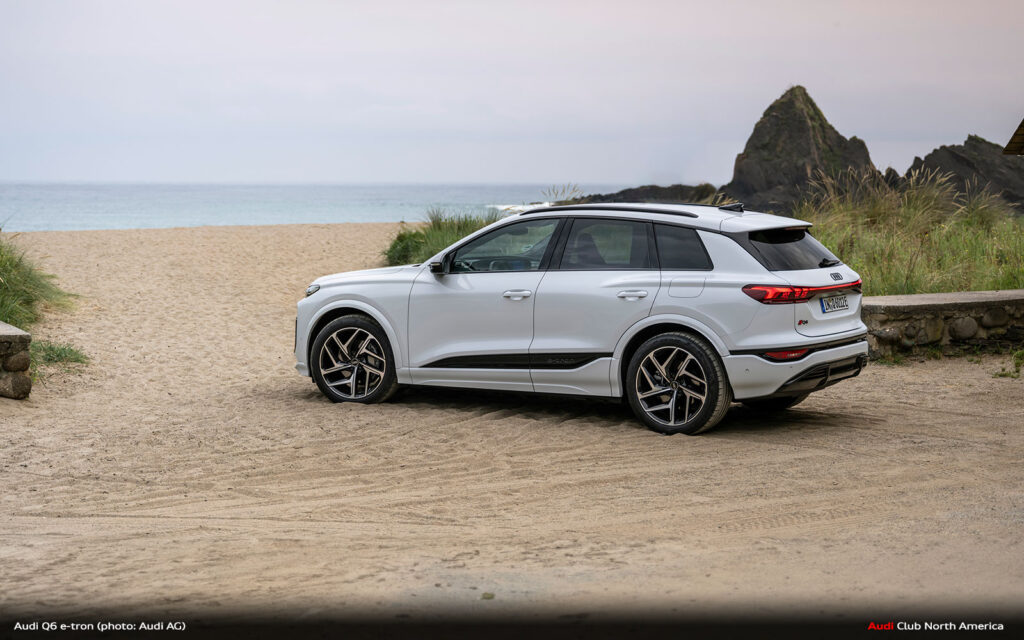
Audi USA Announces Pricing and Specs of Q6 e-tron Model Line Including Range-Leading RWD Model
- With a starting MSRP of $63,800, the 2025 Audi Q6 e-tron is the entry point to Audi’s most technologically advanced BEV, and the vanguard for the next-generation of Audi models to be introduced over the next two years
- Q6 e-tron RWD goes further than any e-tron model with an EPA-estimated range of 321 miles when equipped with ultra package
- Pricing and specifications for the entire Q6 e-tron model line now available on the audiusa.com configurator with deliveries beginning before end of 2024
RESTON, VA – Audi of America today released full pricing and specifications for the all-new 2025 Q6 e-tron model line and announced an additional range-leading rear-wheel-drive (RWD) entry will join its line-up before the end of the year. With today’s announcement, Audi will have 11 distinct battery electric vehicles on offer across its four e-tron model lines at the close of 2024; Q4 e-tron, Q6 e-tron, Q8 e-tron and e-tron GT. The introduction of the Q6 e-tron to the brand’s U.S. model portfolio later this year also marks the start of the most ambitious product introduction cadence in the brand’s history. The all-new Premium Platform Electric (PPE) architecture on which the Q6 e-tron is built is also joined by the introduction of a new Premium Platform Combustion (PPC) which underpins new internal combustion engine Audi models, like the all-new A5 and Q5 arriving next year. Across these two platforms, Audi intends to introduce more than 20 all-new or significantly updated models over the next two years globally, half of which will be electrified.
The rear-wheel drive Audi Q6 e-tron joins the Q6 e-tron quattro and the SQ6 e-tron as the brand’s first model line using the all-new, technologically advanced PPE architecture and introduces new technologies including an all-new MMI user-interface supported by the brand’s all-new E3 electronics architecture. Built to epitomize the brand’s philosophy of Vorsprung durch Technik – or “progress through technology”– the Q6 e-tron marks the next big step for Audi electrification to deliver a seamless EV ownership experience. The addition of the rear-wheel drive Q6 e-tron also places the new model as the longest-range SUV in the brand’s growing battery electric vehicle (BEV) lineup, with the new model earning an EPA estimated driving range of 321 miles when equipped with the ultra package. Together, the Q6 e-tron sets the new standard for Audi electrification: Delivering impressive dynamics with advanced tech, greater range than other e-tron models before it, a new MMI and interior concept, and everyday usability, all starting from $63,800.
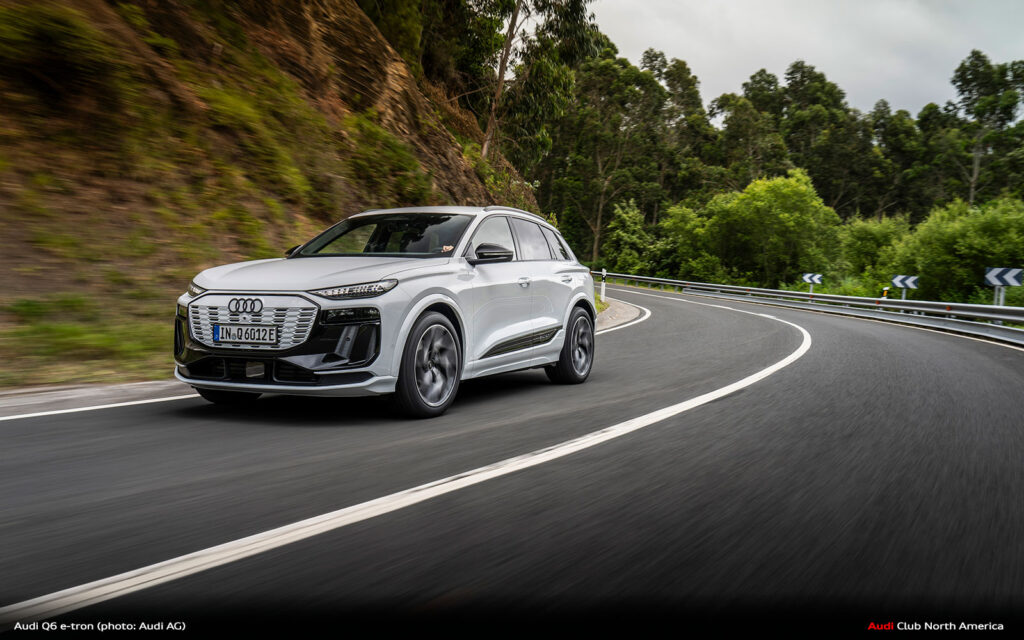
Powertrain, performance and range
The 2025 Audi Q6 e-tron will launch in the U.S. with three different derivatives before the end of 2024; the rear-wheel drive Q6 e-tron, as well as all-wheel drive Q6 e-tron quattro® and SQ6 e-tron models. Coupled with a broad portfolio of the latest technology and safety features thanks to the all-new Premium Platform Electric (PPE) and E3 1.2 electronic architecture, all Q6 e-tron models are available in Premium, Premium Plus and Prestige trim levels. Each model sports a 5-link independent front and rear suspension and is rated to tow up to 4,400 pounds. Each model is fit with the same-sized 100-kWh 800-volt battery pack capable of supporting DC fast-charge speeds of 270 kW (260kW on RWD models), returning 10 to 80 percent state of charge (SoC) in as little as 21 minutes, enabling truly useful short charging stops.
The Q6 e-tron generates 302 horsepower (322 hp with launch control) through its single rear motor, helping to accelerate the SUV to 60 mph in only 6.3 seconds, on its way to a top track speed of 130 mph. When equipped with the optional ultra package, which fits 18” 10-spoke design wheels and low rolling resistance summer tires, the Q6 e-tron is EPA rated to achieve 321 miles on a charge, making it the farthest driving Audi BEV in the brand’s lineup.
The Q6 e-tron quattro® offers 422 hp (456 hp with launch control), delivering an estimated 0-60 mph time of 4.9 seconds with launch control from its two (front and rear) electric motors, before achieving a top track speed of 130 mph. 307 miles of electric range are expected on the EPA test cycle with standard equipment. The Q6 e-tron quattro comes standard with 19-inch wheels, with optional 20-inch designs available.
The SQ6 e-tron makes 483 hp (509 hp with launch control) and delivers an estimated 0-60 mph time of 4.1 seconds with launch control, a top track speed of 143 mph, and is rated to achieve an electric range of 275 miles on the EPA test cycle. Beyond the additional power, the SQ6 comes standard with 20-inch wheels (with 21-inch wheels available), red brake calipers, sport adaptive air suspension, sport seats, and carbon fiber inlays.
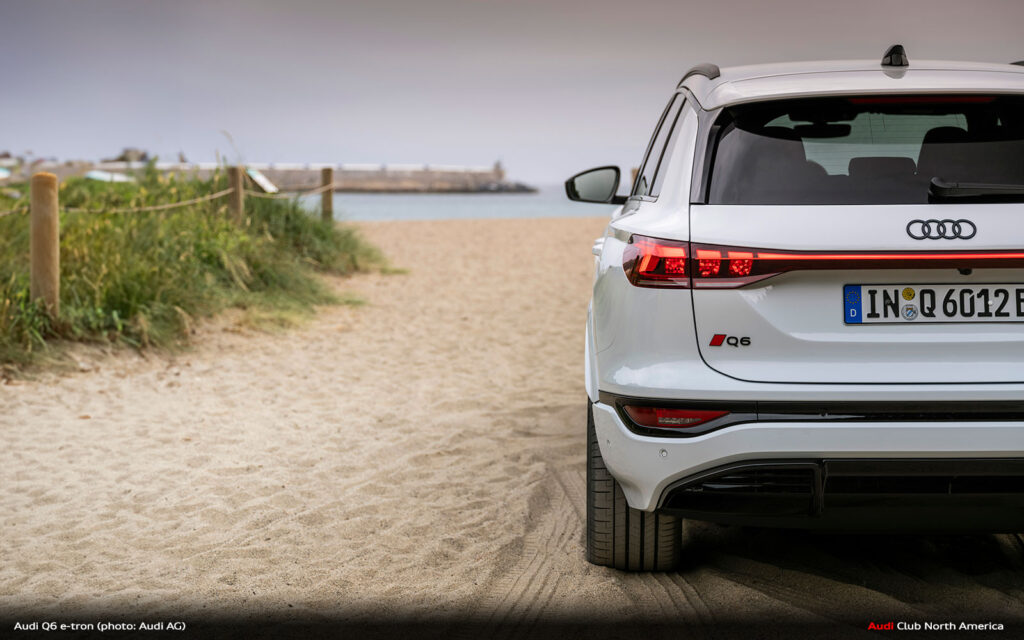
Efficient new motor designs
All Q6 e-tron models feature a redesigned, more efficient and more compact permanently excited synchronous (PSM) rear motor compared to the Audi BEVs that came before it. Operating at a final drive ratio of 9.242:1, the rear motor weighs only 261 pounds, and losses caused by drag in the drive system were reduced by approximately 50 percent from the first generation of Audi electric drive systems.
Direct cooling of the rear electric motor via a dry-sump electric oil pump keeps components like the stator winding and permanent magnets in the rotor in the optimal temperature range. As a result, the drive system’s power-to-weight ratio for the PPE electric drive system is about 60 percent higher than that of the first-generation Audi electric drive systems.
Q6 e-tron quattro and SQ6 e-tron models add a new asynchronous AC induction motor (ASM) on the front axle as well. Both the front and rear motors’ compact designs were engineered for scalability and adaptation based on application; in addition to the Q6 e-tron, the motors will power a number of future Audi products underpinned by the new PPE architecture, like the new A6 and S6 e-tron models on sale next year.
Torque output can be varied by simply adjusting the length of the motor. The new electric motors also require about 30 percent less installation space than those previously used in other Audi BEV models. Additionally, the new design has made it possible to reduce the weight of the motor by about 20 percent from similarly sized previous generation Audi motors. The front ASM motor, operating at a 9.191:1 final drive ratio, weighs only 193 pounds.
A significant advantage of the redeveloped electric motors is their efficiency. The primary contributors to this are a new hairpin design of the windings in the stator, the addition of silicon carbide semiconductors in the pulse width modulating inverter, and a dry-sump electric oil pump in the transmission. The new hairpin winding maximizes current conduction in the electric motor’s stator and allows for higher winding counts. The fill factor has increased to 60 percent, instead of 45 percent when compared to the previously used conventional motor windings. In total, losses caused by drag in the electric drive systems were reduced by approximately 50 percent from the first-generation of Audi electric drive systems.
When accelerating under full power, the asynchronous motor (ASM) on the front axle of Q6 e-tron quattro models is almost instantly engaged. Due to the nature of its construction, the ASM does not contain any magnets – instead generating its magnetic field through induction – so when unpowered, it can spin freely without significant drag losses.
Motor acoustics have also been improved versus previous generation Audi BEVs. Casting the motor mounts directly onto the housing structurally optimizes the acoustic transfer path, while segmenting the rotor reduces the amplitude of the spatial harmonics, resulting in NVH improvements over the first-generation Audi e-tron.
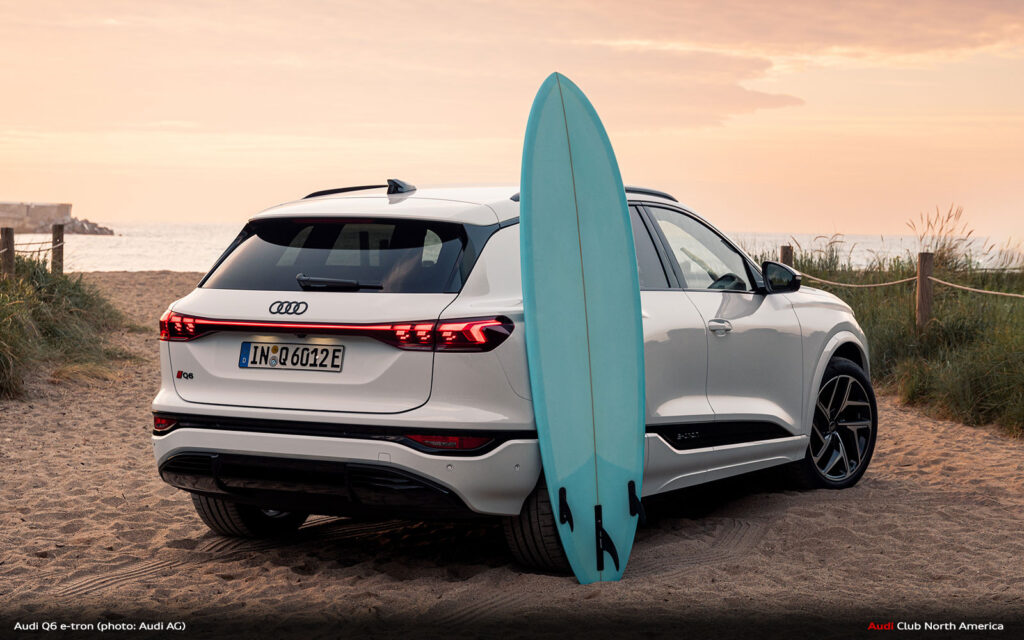
Advanced battery-charging capabilities
All Q6 e-tron models benefit from a lithium-ion battery pack composed of 12 modules of 15 prismatic cells connected in series for a total of 180 cells, with a total gross capacity of 100 kWh
(94.4 kWh net). A maximum DC fast-charging capacity of 270 kW (260kW on RWD models) is standard and is fundamentally enabled by its 800-volt architecture, new preconditioning features of the battery, and the PPE’s new predictive thermal management.
Standard Level 2 AC charging, most commonly used with home chargers, is supported at rates up to 9.6kW (240V/40A). An optional onboard charging setup, anticipated to be available at a later date, will support AC charging rates up to 19.2 kW (240V/80A). If a charging station works with 400V technology, the Q6 e-tron can enable bank charging, automatically dividing the pack into two batteries at equal voltage, which can then be charged in parallel at 135 kW. Depending on the state of charge, both halves of the battery are first equalized and then charged simultaneously, shortening overall recharge times.
All models of the Q6 e-tron come standard with the convenient Plug & Charge function and one year of unlimited DC fast charging included at no additional cost via the Electrify America network which streamlines the charging process at select charging stations. At compatible Electrify America charging stations and when activated in the MyAudi App account, the Plug & Charge feature automatically authorizes and confirms billing via encrypted vehicle to infrastructure (V2i) communication, activating the charger simply by inserting the plug into the vehicle; eliminating the need to produce a credit card or RFID payment at the charger.
A reduction in the overall number of battery cells, along with intelligent, high-performance and predictive thermal management is a key component of the impressive charging performance of the PPE-based Q6 e-tron. Compared to the battery systems Audi has used to date, the battery for the Q6 e-tron (12 modules/180 cells) has fewer components. For comparison, the battery in the Q8 e-tron is made up of 36 modules and 432 cells. The significant enlargement of the cells in the Q6 e-tron corresponds closely to the system voltage of 800 volts, achieving the best balance between range and charging performance.
The reduction in the number of modules for the PPE batteries offers other advantages. The battery, which can be used modularly for high-floor (SUV) and flat-floor (sedan) models, requires less installation space, is lighter, and can be better integrated into the vehicle’s crash structure and cooling system. It also requires fewer cables and high-voltage connectors, and the number of bolted fastenings has been significantly reduced. Additionally, the electrical connections between the modules are shorter, which substantially reduces losses and weight.
A cooling plate integrated into the battery housing ensures homogeneous heat transfer and therefore near-optimal battery conditioning. The protective side skirts made of hot-formed steel are not affixed to the battery, but instead attached securely to the vehicle body. The underbody cladding made of fiber composite material is also new. This construction further reduces weight and improves the thermal insulation between the battery and the environment. This allows the PPE’s battery to be heated or cooled more efficiently.
For the PPE, the ratio of nickel to cobalt and manganese in the battery cells is approximately 8:1:1, with a reduced proportion of cobalt and an increased proportion of nickel.
An important component in increasing the efficiency and therefore contributing to the overall range of the Q6 e-tron is the advanced recuperation system. Around 95 percent of all everyday braking events can be handled by this setup, and the Q6 e-tron recuperates braking energy at up to 220 kW. The regenerative braking system on the Q6 e-tron is more seamless than ever, being significantly further developed on the PPE thanks to axle-specific brake blending, which helps improve the natural brake-pedal modulation feel. The regenerative brake system has five different modes, including a true One-Pedal Drive B-mode that can bring the vehicle to a complete stop at braking forces up to 0.25 g with no low-speed creeping. Three manual deceleration modes controlled by the steering-wheel paddles all provide the familiar low-speed creep found in combustion vehicles and can be set for strong deceleration (0.15 g), medium deceleration (0.06 g) or coasting. A fifth deceleration mode, Auto, helps optimize efficiency by utilizing the forward-facing camera to determine if regenerative braking or coasting is more efficient depending on traffic and road gradient, while also providing low-speed creep.
The battery management controller (BMC), a central control unit developed specifically for the PPE, is responsible for the current control required for fast and battery-saving charging. The BMC is completely integrated in the battery, and as part of its continuous monitoring, the twelve cell module controllers (CMS) send data such as the current module temperature or the cell voltage to the BMC, which sends its information to the high-performance computer that is part of the new E3 1.2 electronic architecture. This computer, in turn, sends data to the new predictive thermal management, which regulates the cooling or heating circulation as needed for optimal battery performance.
Efficient thermal management of the PPE architecture enables shorter charging times, increased range, and a longer service life compared to prior Audi models. Predictive thermal management uses data from the navigation system, desired route, departure timer, and customer’s usage behavior to calculate the need for cooling or heating in advance and provide it efficiently and at the right time. If a customer is using the Audi navigation system to route to a DC fast-charging station, the predictive thermal management prepares the DC charging process and cools or heats the battery so that it can charge faster, thus reducing charging time. The thermal management system also works with the vehicle’s navigation system to determine if there is a steep grade ahead and adjusts the battery’s temperature by appropriately cooling it to prevent a higher thermal stress.
If the driver has selected efficiency mode, the conditioning of the battery is activated later, which is designed to be able to increase range, depending on driving behavior. In dynamic mode, if the current traffic situation does not allow for dynamic driving, the thermal management will react to this and minimize the energy usage for battery conditioning.
Post-conditioning and continuous conditioning are also new in the PPE thermal management system and contribute to extended battery service life. These functions monitor the battery temperature for the car’s entire service life to help ensure the battery is kept in the optimal temperature range, such as after a high-speed-charging session, or even when the vehicle is not moving – for example in the case of very hot weather.
With the thermal management system directing coolant below the modules to provide consistent temperature homogeneity within the battery, performance can be increased. The battery cooling plate is also a structural component of the battery, allowing an additional floor panel in the battery-housing space to be eliminated, with the thermal connection to the modules optimized thanks to a heat-conducting paste.

Exterior design
The Audi Q6 e-tron is aimed at the heart of the premium mid-size SUV segment, electrifying the role currently held solely by Audi’s best-selling Q5 lineup. The Q6 e-tron slots perfectly into Audi’s expanding electrified SUV portfolio; offered between the larger Q8 e-tron and smaller Q4 e-tron. With a length of 187.8 in., a width of 76.3 in., a height of 66.6 in., and a wheelbase of 113.7 in., the Q6 e-tron offers a surprisingly spacious interior and true SUV proportions that provide excellent visibility from an elevated seating position. This is combined with the extensive standard comfort features and remarkable everyday practicality expected by owners of a premium luxury SUV.
The new PPE architecture affords the Q6 e-tron an exceptionally handsome exterior. Combining a long wheelbase with very short overhangs to inform its design – the Q6 e-tron embodies an evolution of the familiar dynamic proportions and volume found in other Audi Q models – with several new design elements developed for the Q6 e-tron which will find their way into future Audi products. The striking form elicits a strong impression at first glance and its sporty appearance underscores the model’s performance and athleticism.
Throughout the car’s exterior, the elegant surfaces of the front fender, hood and body side are juxtaposed by more structured elements which integrate crisp creases and edges. Surfacing the vehicle in this way provides two distinct benefits; visually segmenting the vehicle to make it appear smaller and more dynamic, whilst also improving air flow around the vehicle in some cases.
A prominent line running from the rear lights to the rear doors and through to the front fender emphasizes the upper section of the Q6 e-tron’s “quattro blisters,” the contours of the body on which the gently sloping A and D pillars are supported. The blisters are a core element of Audi’s signature design DNA – a central design principle called “making technology visible” – with visually tightened aft structures creating a mixture of elegance and power. The clean and broad rear architecture with its continuous light strip lends the Q6 e-tron a sense of clarity and confidence typical of Audi.
The upright front of the car is immediately recognizable with the brand’s e-tron characteristic closed Singleframe grille, first found on the e-tron GT, masked in either selenite silver or gloss black. New to the Q6 e-tron are a pair of highly positioned digital daytime running lights above the optional LED headlights plus, marking the first-time a quad headlight design has found its way into an Audi product and lending the model a more distinctive and independent appearance.
The greenhouse of the Q6 e-tron is stretched low and taut over the powerful bodywork. It is slightly tapered towards the rear and the gently sloping D pillars flow elegantly into the bodywork’s muscular shoulders. The opening between the D pillar and the roof gives the vehicle a more energetic appearance, while making the cabin appear longer.
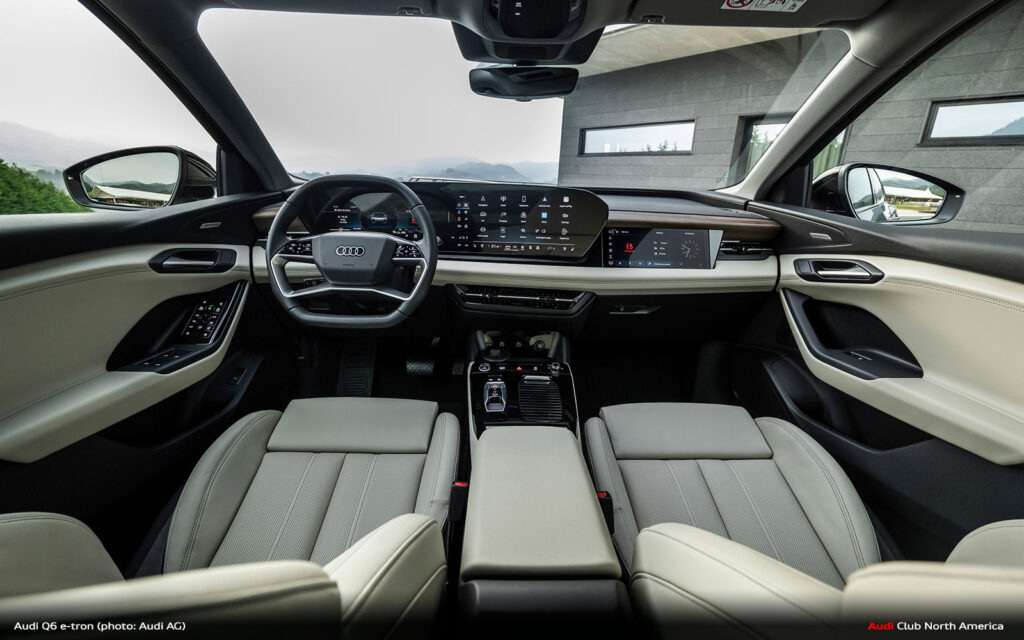
Interior design
Thanks to the new PPE, the vehicle has generous space and roominess as well as a high level of everyday practicality. The interior offers plenty of space for both occupants and luggage, due to the 38.5-inches of front headroom, and 30.2 cu ft of storage space behind the second row of seating. When the rear seats are folded, storage space increases up to 60.2 cu ft. The rear seats can be folded down separately in a 40:20:40 configuration, and additional storage is available in the front trunk.
More than ever, the interior design of the Q6 e-tron is orientated towards the needs of the user. The three-dimensional, high-contrast design of the interior deliberately places elements in the foreground or background, creating a spatial architecture that is tailored to the occupants in terms of design and ergonomics, while simultaneously emphasizing a comforting ambience.
High-quality materials extend from the doors across the entire cockpit to the center console, creating a homogeneous and enveloping feeling of space. The same colors and materials can also be found in the seats. The materials used were selected from a functional point of view and at the same time ensure a clear design differentiation between the various areas of the interior. Comfort-oriented areas are designed with generous surfaces and soft materials. In contrast, the precisely designed control areas in high-quality high-gloss black create a clean space for interaction.

New technologically advanced architecture
Marking its debut in the 2025 Audi Q6 e-tron, the new E3 1.2 high-performance and future-oriented electronic architecture permits customers to directly experience the benefits of a digitalized vehicle communications framework. The E3 nomenclature stands for “End-to-End Electronic architecture.” Based on a new domain computer structure with five high-performance computers, the new E3 1.2 architecture controls all vehicle functions, from infotainment and driving modes, through to semi-automated driving in later evolutionary stages.
The Q6 e-tron model line has an all-new, fully connected digital interior based on the new E3 1.2 electronic architecture called the Digital Stage. The Digital Stage is comprised of an 11.9-inch Audi OLED virtual cockpit in front of the driver, and a 14.5-inch center touch OLED display, both integrated as one slim, free-standing, curved panoramic design element oriented toward the driver. At night, sleekly integrated ambient lighting makes the Curved Display appear to float above the dashboard.
In addition, for the first time in an Audi, the Q6 e-tron offers an optional 10.9-inch MMI passenger LCD display to complement the Digital Stage. The front passenger display features Dynamic Privacy Mode, which integrates active shuttering technology to prevent it from distracting the driver while moving images are displayed and the vehicle is in motion. This allows the front passenger to stream films or other video content, assist with navigation, or help find a charging station.
The Audi Digital Stage can be further extended with an available second-generation Augmented Reality (AR) Head-up Display (HuD). It reflects an image on the windshield towards the driver, showing relevant information such as speed, traffic signs, assistance, and navigation symbols overlaid on the road ahead. Compared to the first-generation AR HuD found in the Q4 e-tron, the new display provides a higher definition image with improved quality (1152×576 pixels). The image also appears larger and further down the road, reducing focus-shift. To the driver, the display appears to float in front of the vehicle as if projected on an 88-inch display, while certain content can appear to be projected as far as 650 feet down the road. The larger display size and greater distance the information is projected combines to prevent the driver from having to shift focus back and forth between the dashboard displays and the road. The image is now also brighter (13,500 nits) and provides more content, including media titles and charge status to encourage drivers to maintain attention on the road ahead.
The new Audi infotainment system uses the Android Automotive operating system for the first time, and the latest Audi connect services and enhanced e-tron route planner come standard. A wide array of apps such as YouTube, Spotify, and Zoom are available via the Audi App store and can be integrated directly into the MMI without the use of a smartphone.
The all-new infotainment system is available with two different Bang & Olufsen Premium sound systems, with up to 830-watts of amplified sound. On models with the optional sport seats, the premium sound system drives 20 loudspeakers, including four integrated into the front-seat headrests, enabling sound zones for the first time in an Audi. The sound zones enable audio to be intelligently routed for phone calls or specific cues such as navigation.
Helping owners access all the new functionalities of the Q6 e-tron, Audi has integrated a new self-learning voice-activated system called Audi Assistant. Deeply integrated into the vehicle, Audi Assistant activity is displayed using an avatar in the central touch display of the MMI, as well as in the Augmented Reality Head-up Display. The new voice assistant controls more than 800 functions, with more than 100 voice commands each possible, and has the ability to understand 23 different languages. The system responds with surprising swiftness, and can also be activated via various touchpoints and via the myAudi app.
The voice assistant learns continuously based on user behavior, providing support to the person driving. This support can be grouped into three categories: proactive suggestions (contextual information is used to proactively suggest functions for activation based on this data); smart routines (automatically recognizing recurring operating sequences, such as using the seat climate control for certain outside temperatures); and intelligent lists (such as call lists). The spoken commands are also shown on the display (a see-what-you-speak principle) and become more useful over time as the system adapts to the driver’s routines and speech patterns.
Spanning the full width of the lower windshield and extending into the A-pillar areas of the front dashboard, for the first time in an Audi, a new dynamic interaction light communicates key vehicles functions to the occupants at a glance. Comprised of 84 LED elements, the light communicates a host of information including directional cues for navigation, hazard warnings and easily discernible charging status cues visible from outside the vehicle.
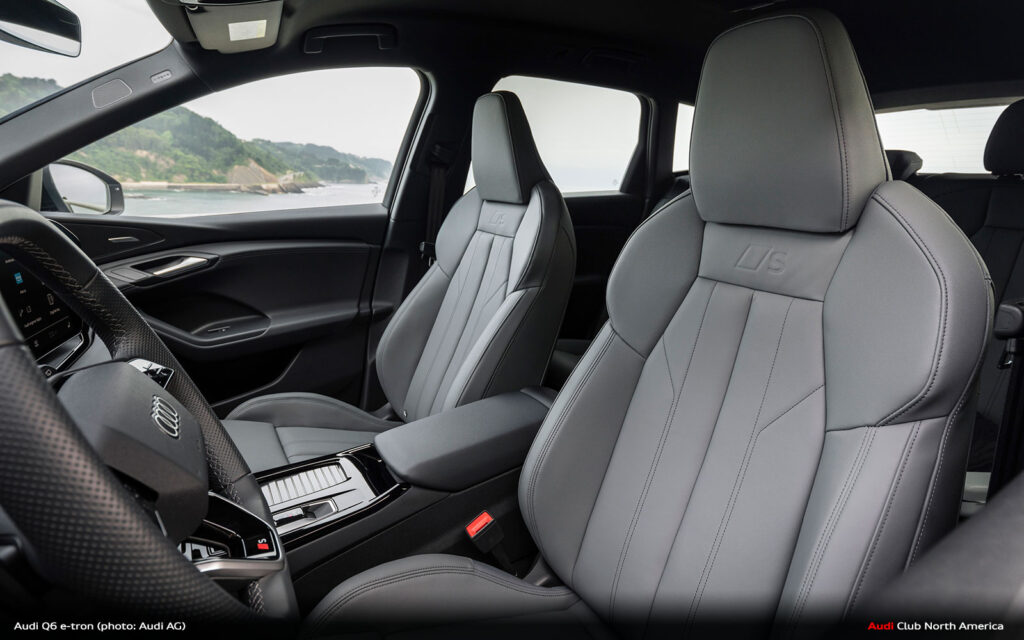
New generation safety-enhancing/ADAS features and tech
Providing a wide range of functions that significantly help improve everyday driving for all road users is the goal behind the high level of standard ADAS features found on the Q6 e-tron. The completely new suite of features includes Adaptive cruise control, Lane change warning, Exit warning, Collision avoidance assist, Emergency brake assist, Traffic sign recognition, swerve assist and front turn assist, and a distraction and drowsiness warning system. Also new with the Q6 e-tron is rear turn assist, which can help prevent or mitigate collisions at intersections, side roads, courtyards or garage entrances, by informing about cyclists or other vehicles approaching from behind, and rear occupant detection, which can help prevent unintentionally leaving a child or pet unattended in the back seat.
Another new feature for the Q6 e-tron is the optional Adaptive cruise assist plus, which combines the functions of adaptive cruise control and the lane keeping assistant. The system helps with acceleration, maintaining speed, keeping safe following distances, as well as lane guidance by using the radar sensors, the front camera, and the ultrasonic sensors. The system works across the entire speed range and in traffic jams and has been tailored to provide greater efficiency and to optimize passenger comfort.
Deliveries to begin before end of 2024
The 2025 Audi Q6 e-tron, Q6 e-tron quattro®, and SQ6 e-tron will arrive in U.S. dealerships before the end of 2024, with pricing from $63,800.
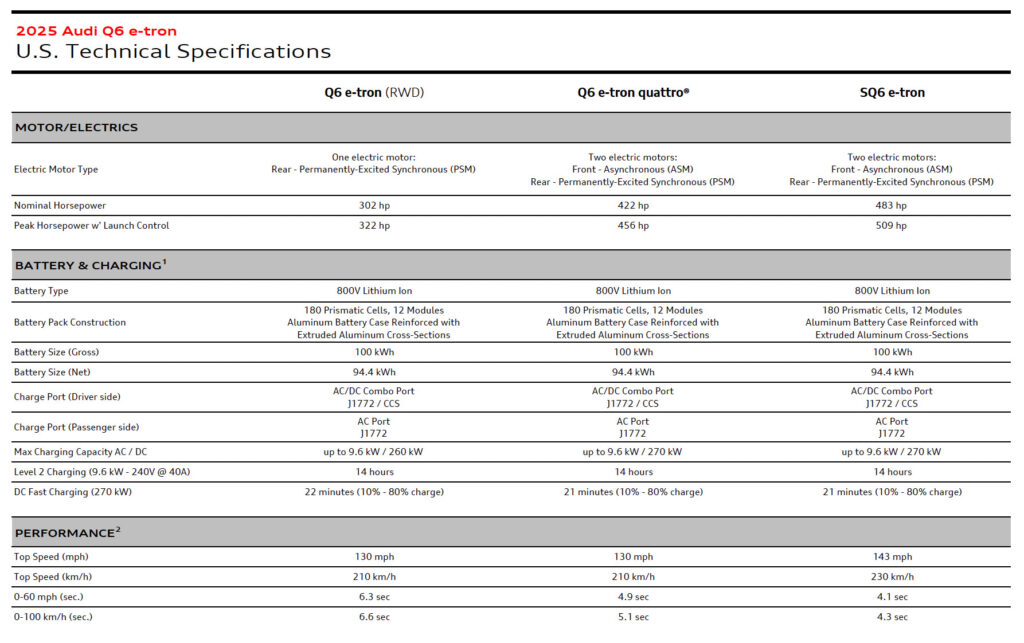



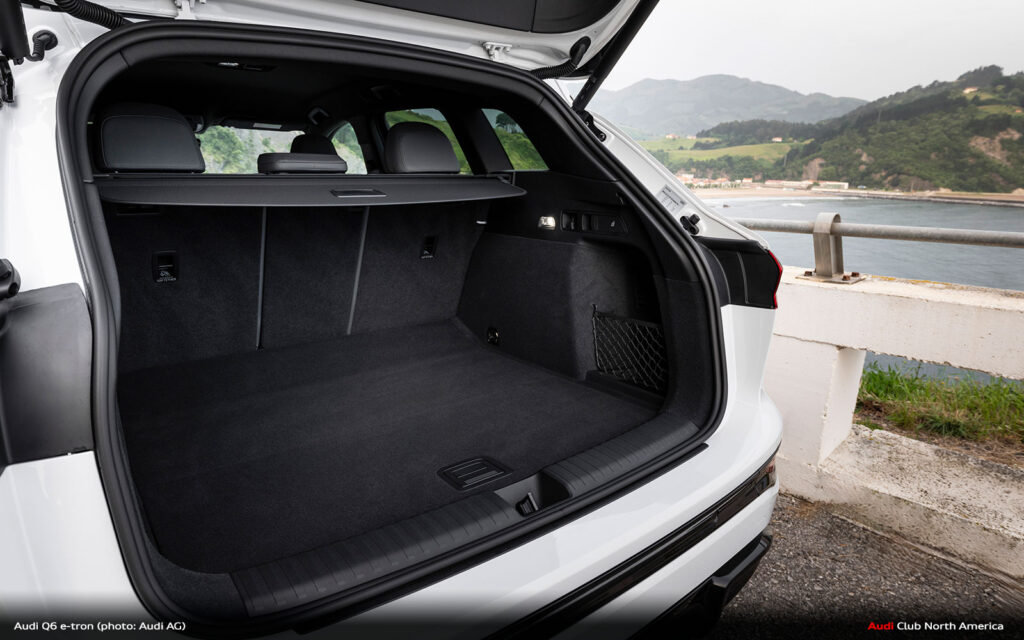










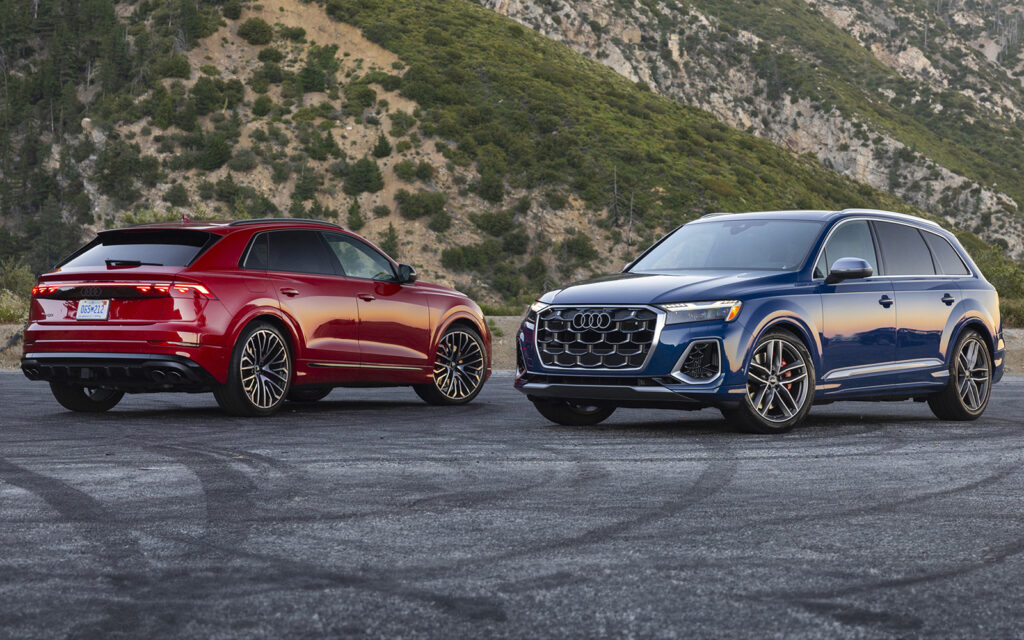
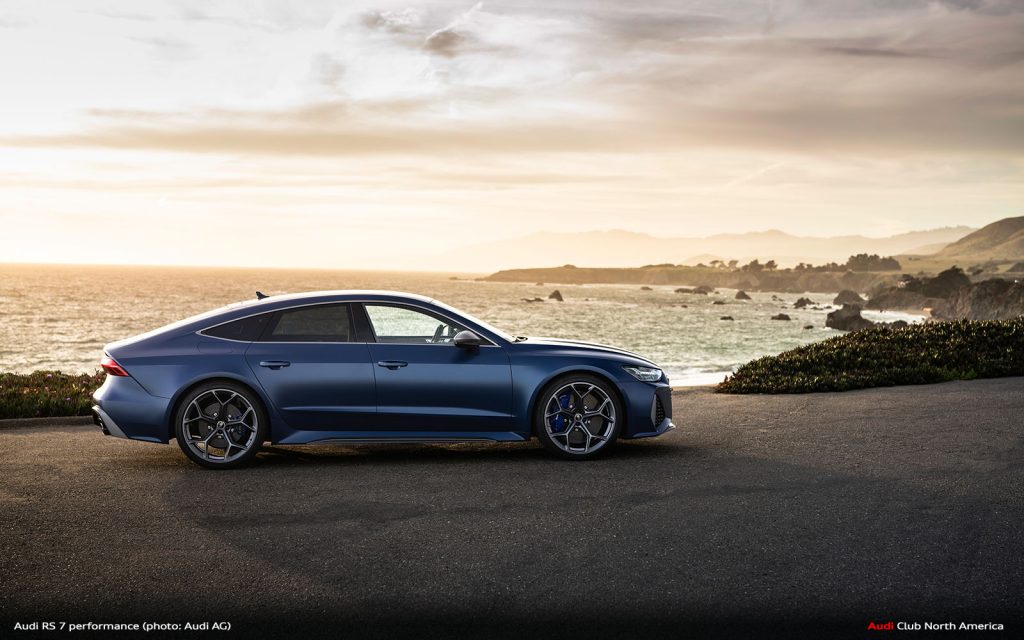

Responses